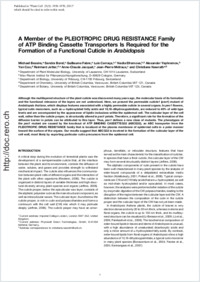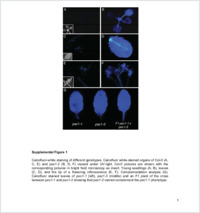A member of the PLEIOTROPIC DRUG RESISTANCE family of ATP binding cassette transporters is required for the formation of a functional cuticle in Arabidopsis
- Bessire, Michael Department of Plant Molecular Biology, University of Lausanne, Switzerland
- Borel, Sandra Department of Plant Molecular Biology, University of Lausanne, Switzerland
- Fabre, Guillaume Department of Plant Molecular Biology, University of Lausanne, Switzerland
- Carraça, Luis Department of Plant Molecular Biology, University of Lausanne, Switzerland
- Efremova, Nadia Max Planck Institut für Pflanzenzüchtungsforschung, Cologne, Germany
- Yephremov, Alexander Max Planck Institut für Pflanzenzüchtungsforschung, Cologne, Germany
- Cao, Yan Department of Chemistry, University of British Columbia, Vancouver, Canada
- Jetter, Reinhard Department of Chemistry, University of British Columbia, Vancouver, Canada - Department of Botany, University of British Columbia, Vancouver, Canada
- Jacquat, Anne-Claude Department of Biology, University of Fribourg, Switzerland
- Métraux, Jean-Pierre Department of Biology, University of Fribourg, Switzerland
- Nawrath, Christiane Department of Plant Molecular Biology, University of Lausanne, Switzerland
-
31.05.2011
Published in:
- Plant Cell. - 2011, vol. 23, no. 5, p. 1958-1970
English
Although the multilayered structure of the plant cuticle was discovered many years ago, the molecular basis of its formation and the functional relevance of the layers are not understood. Here, we present the permeable cuticle1 (pec1) mutant of Arabidopsis thaliana, which displays features associated with a highly permeable cuticle in several organs. In pec1 flowers, typical cutin monomers, such as ω- hydroxylated fatty acids and 10,16-dihydroxypalmitate, are reduced to 40% of wild-type levels and are accompanied by the appearance of lipidic inclusions within the epidermal cell. The cuticular layer of the cell wall, rather than the cuticle proper, is structurally altered in pec1 petals. Therefore, a significant role for the formation of the diffusion barrier in petals can be attributed to this layer. Thus, pec1 defines a new class of mutants. The phenotypes of the pec1 mutant are caused by the knockout of ATP BINDING CASSETTEG32 (ABCG32), an ABC transporter from the PLEIOTROPIC DRUG RESISTANCE family that is localized at the plasma membrane of epidermal cells in a polar manner toward the surface of the organs. Our results suggest that ABCG32 is involved in the formation of the cuticular layer of the cell wall, most likely by exporting particular cutin precursors from the epidermal cell.
- Faculty
- Faculté des sciences et de médecine
- Department
- Département de Biologie
- Language
-
- English
- Classification
- Biological sciences
- License
-
License undefined
- Identifiers
-
- RERO DOC 24850
- DOI 10.1105/tpc.111.083121
- Persistent URL
- https://folia.unifr.ch/unifr/documents/302117
Other files
Statistics
Document views: 106
File downloads:
- pdf: 213
- Supplementary material: 155

